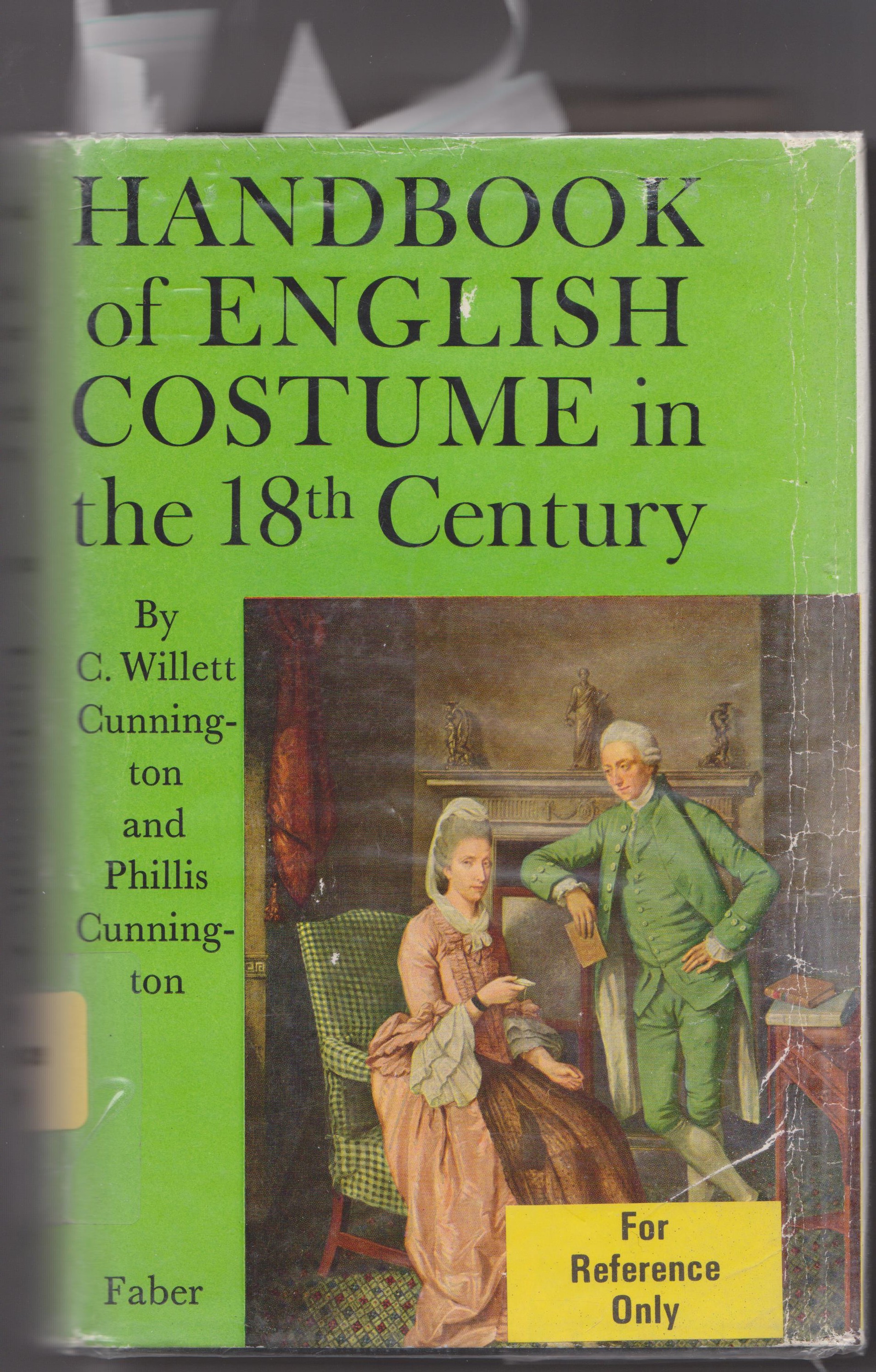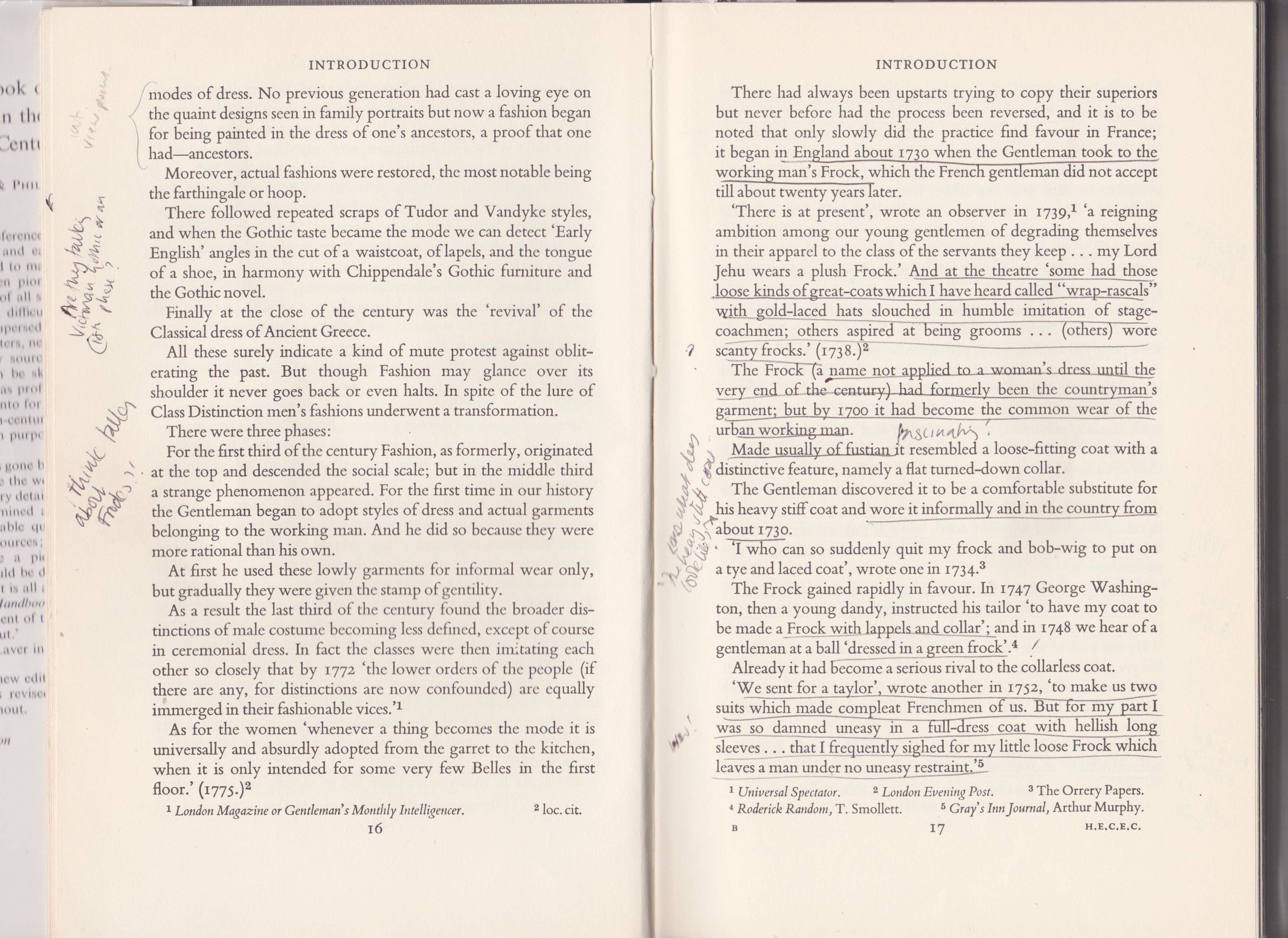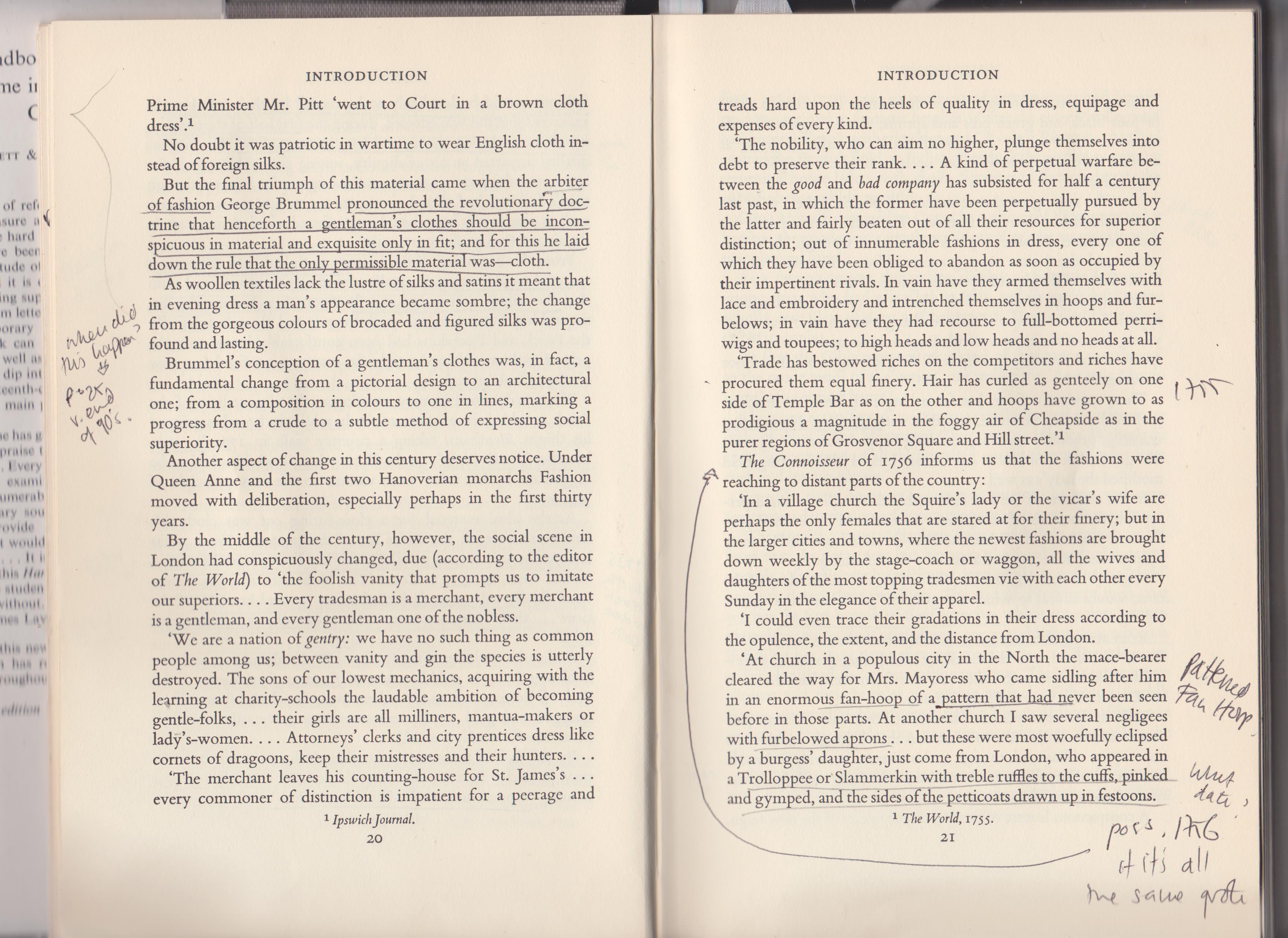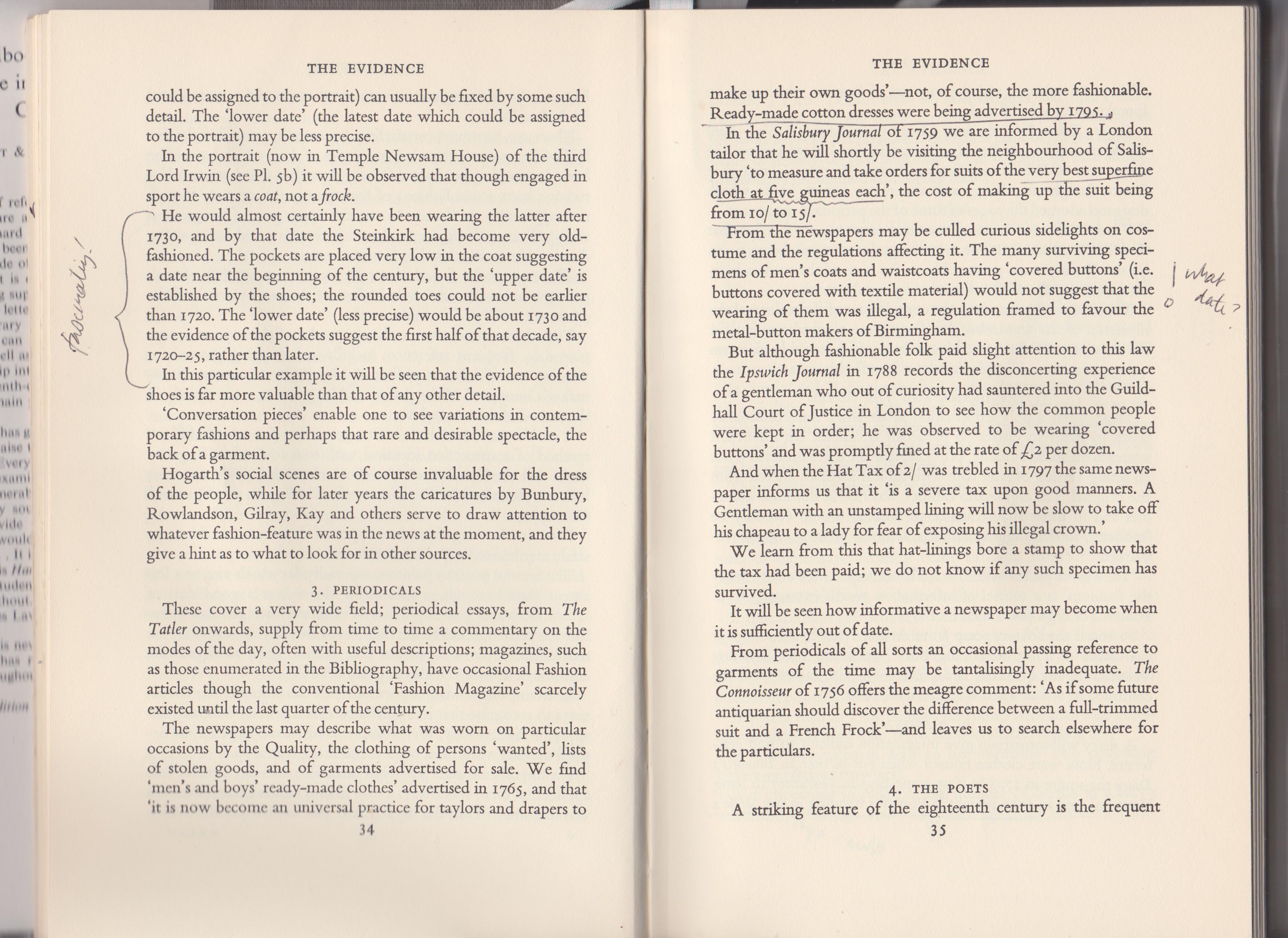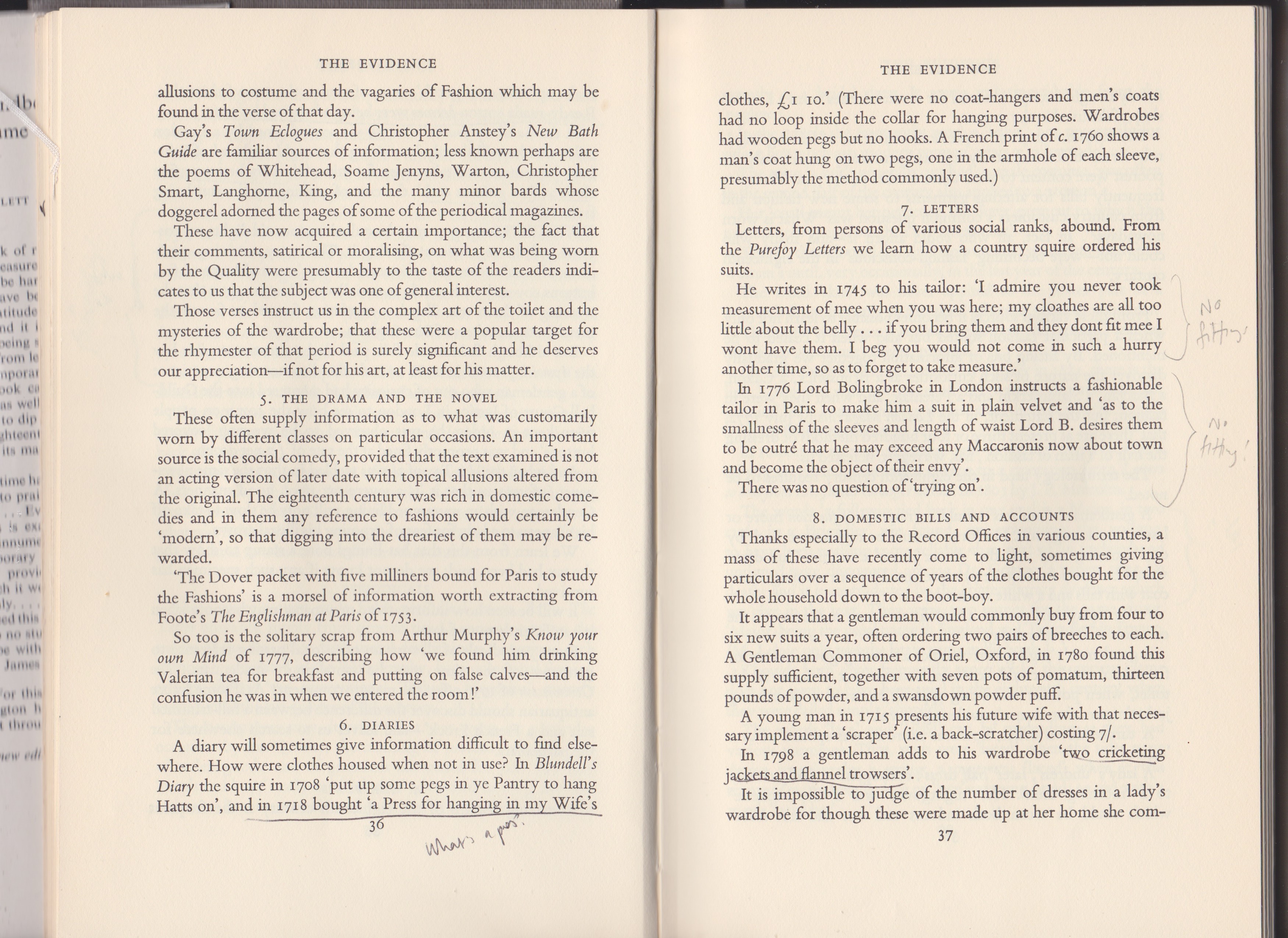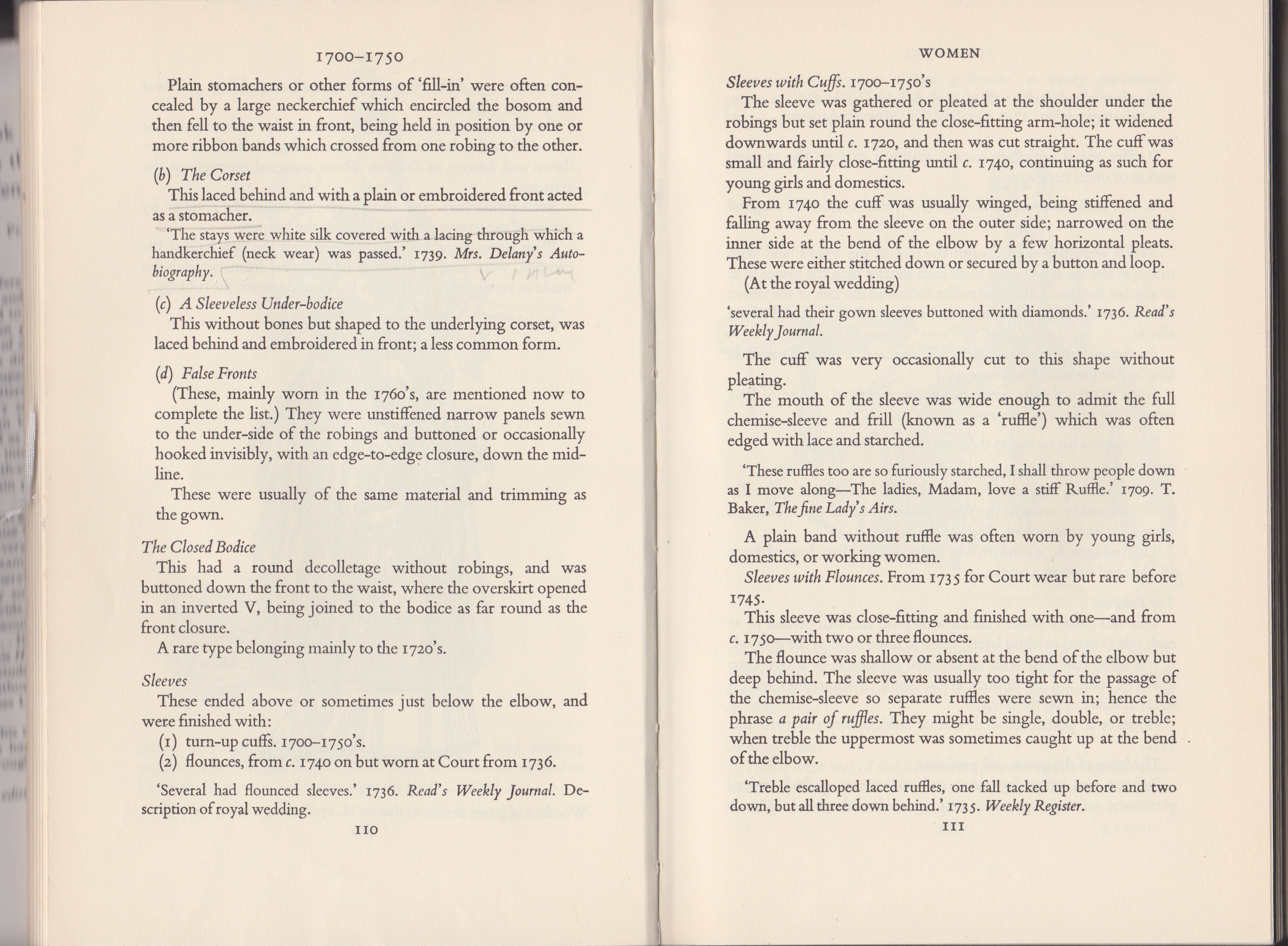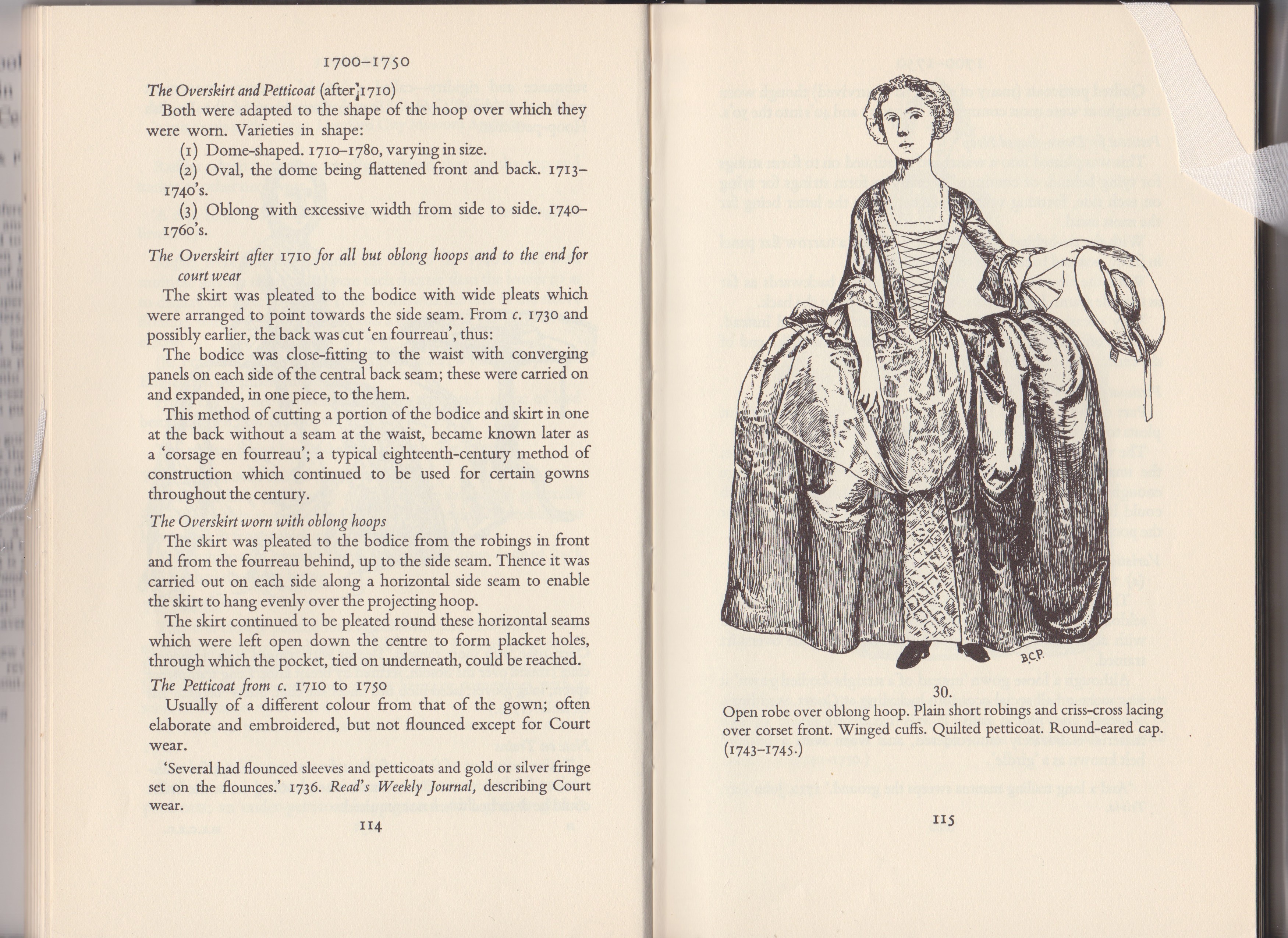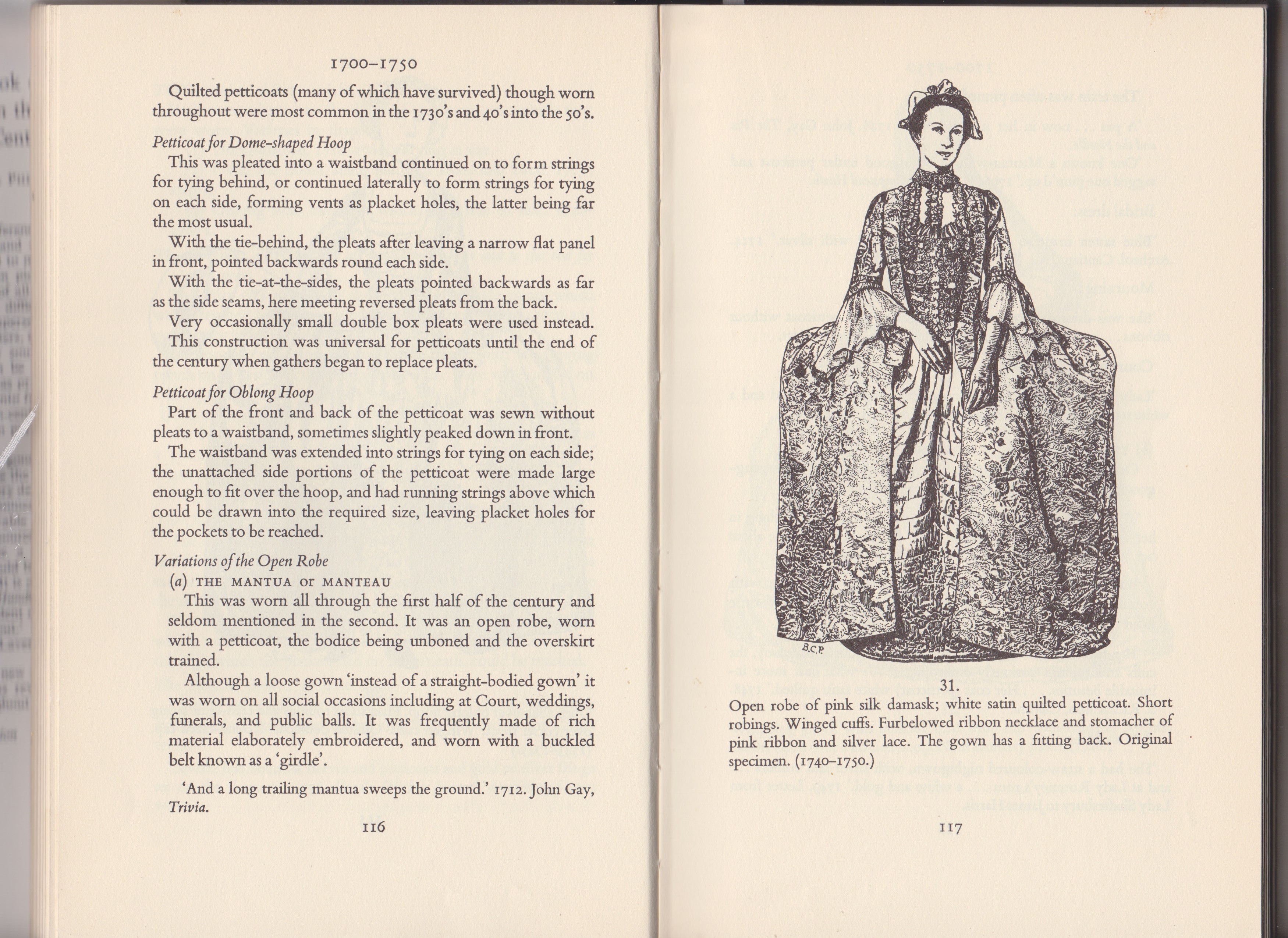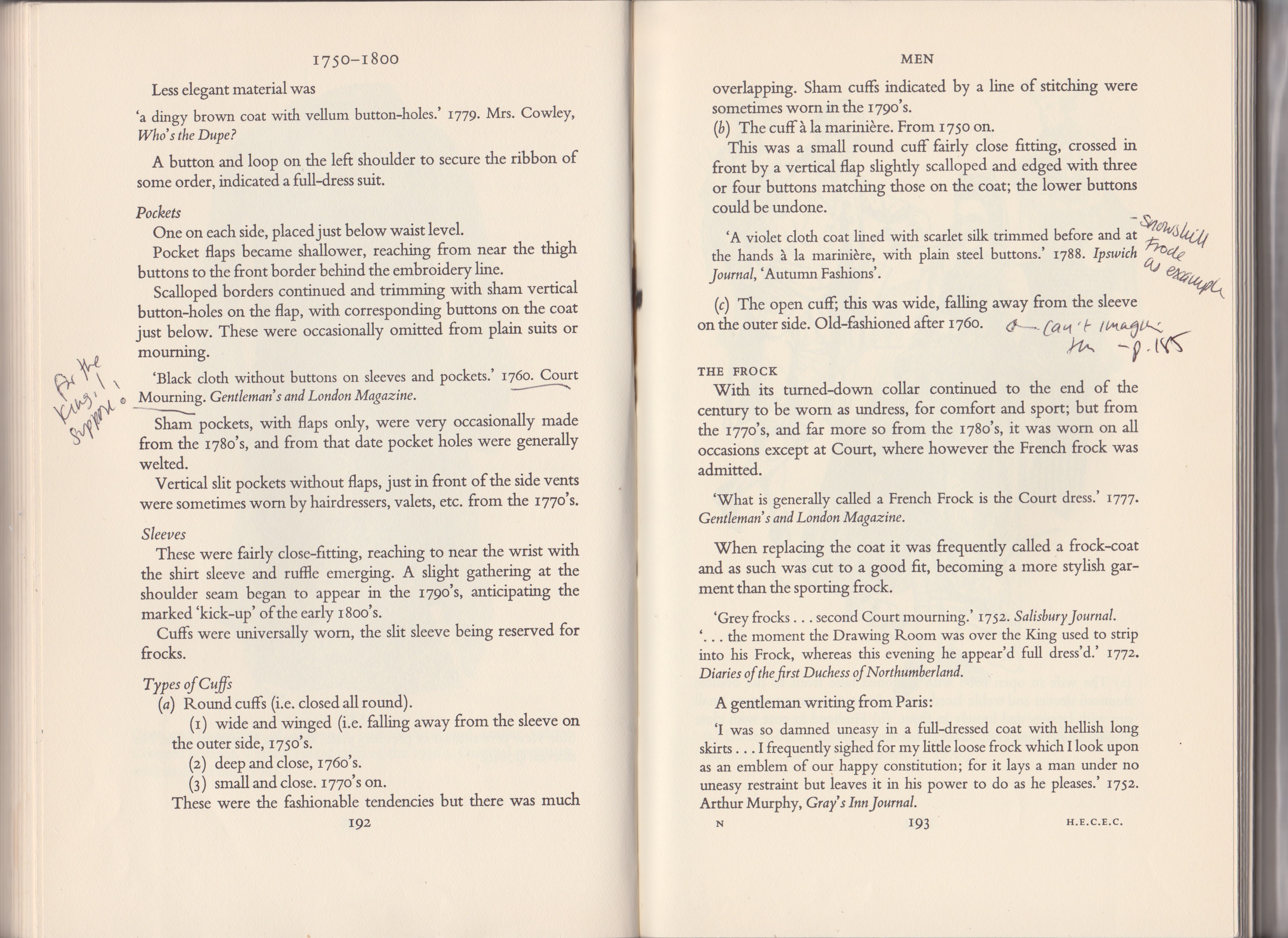Handbook of English Costume in the 18th Century
By C.Willet Cunnington and Philis Cunnington – 1964
Every time we study a painting we have a small pile of books at our side: I.Brooke, A.Buck, J.Arnold etc etc….and the Cunnington’s. I’m sure you can tell from our many previous pages that we use the Cunnington’s a lot but there is a simple reason for this: many of the other historians deal tremendously with the growing and changing breezes of fashions, the move of the years through the century, the comings and goings of the Court life but it’s the Cunningtons that have quietened all that noise down and gotten back down to the basics. In this book they have broken apart up each item of costume and describe it’s various styles. And a lot of their knowledge comes from the collection of costumes they personally gathered together and which formed the beginning costume collection to the Manchester Costume Gallery.
There is not a book like this in all of the rest of the Historical Costume books.
Description:
We read this many years ago where we were first starting our research into the 18th century but back then it was a lot of detail that had nowhere to root itself in our totally blank minded understanding of 18th Century fashion. The more we read it now, the more we go ‘oh yeah – we saw that in such-a-such painting’ and can go back and look up on it. It’s always teaching us something.
However, it is not perfect.
For example, we’re a complete blank as to the way they totally miss out Stays in their discussions. ‘The Corset’ only comes into mention on p.110 when discussing Stomachers and which they distinctly call a corset rather than ‘stays’ even when the quote they use contains that very word. It’s so strange, as they are normally quite clear in the way they clarify what is a contemporary term and what is modern. We don’t understand it at all. They have another book – a Dictionary of English Costume (Bibliography page coming soon) and there’s barely a mention of stays in that either. On p.204 – there’s a small excerpt for the word ‘STAYS; but it literally only says: ‘The earlier name for Corsets,q.v.. ‘.Go then to the word ‘Corsets’ and it says ‘Corset or Stays. End of 18th c,.on’ !!!! What’s that about? They’ve seemingly skipped the entire 18th c of it’s boned garment. If you go to the Index page in our book here you can see for yourself there’s not a single reference to Stays bar the page number for a mentioning of ‘Stay Hooks’ (p.179 and p402 if you’re interested). Neither do they mention Corsets. Most Odd.
There seems to be a lot of critiscm from other Historians in the way they have interpreted some of the women’s fashion – suggesting that they viewed it in a very old fashioned and sexist way, and therefore some of their conclusions need to be treated a little bit with care. They’re pretty useless on Shifts too lol.
Chapter Breakdown:
– There’s a detailed and worth reading Introduction
– A discussion on the types of Evidence they’ve used which is also important to read.
Then the sections:
– 1700-1750:
Men
Women
– 1750-1800:
Men
Women
– There’s a Glossary of Materials – again incredibly useful.
– Prices of Materials – which would be more useful if we could understand the ratios to todays monetary value.
– Sources and Illustration sources as they have a lot of black and white sketches from key paintings.
In other books we’ve given a much more detailed breakdown description of each chapter but, without writing the whole book here, it’s kind of pointless. There is page after page of valuable info. How could we chose which to print and which to ignore!
I think the way we’re going to do it is simply scan in a selection of our most used pages and do a brief talk on them in their chapter orders.
Introduction:
P.16-17:
Special Details:
-A great classic quote about the movement of Fashion: ‘But though Fashion may glance over it’s shoulder it never goes back or even halts.’
– Talks about the constant fight between genteel fashion and lower fashion. ‘ In fact the classes were then imitating each other so closely that by 1772 ‘the lower orders of the people (if there are any, for disctinctions are now confounded) are equally immersed in their fashionable vices,’
– And ‘As for the women ‘whenever a thing becomes the mode it is universally and absurdly adopted from the garret to the kitchen when it is only intended for some very few belles in the first floor.’
– The Cunningtons begin to talk about the momentous occasion when the ‘For the first time in our history the Gentleman began to adopt styles of dress and actual garments belonging to the working man. And he did so because they were more rational than his own.’ Here they are talking about the Frock and the Great Coat.
– ‘It began in 1730 when the Gentleman took to the working man’s Frock, which the French gentleman did not accept till about 20 years layer’ – just when it was coming into high stream fashion in England.
– That a man wore a ‘green Frock’ for a ball in 1748 which is earlier than we understood, thought the Cunnington’s don’t mention why this was so commented on. It might’ve been because it was so shocking an event for all we know.
P.20-21
Details:
– A great quote giving a picture of contemporary understanding to the distinction of Genteel fashion to those beneath them: ‘…that henceforth a gentleman’s clothes should be inconspicuous in material and exquisite only in fit; and for this he laid down the rule that the only permissible material was – Cloth.’ The fight between what distinguished a gentleman from his lower and mimicking fellows is quite an interesting struggle in the 18th c. Previous to the above quote had been the richness of fabrics and certainly the uncomfortableness of high fashion (I think Brooke mentions a good quote on this! – double check) but now the desire for a well cut and tailored coat.
– There was a complaint that ‘we are a nation of gentry…’ – again bemoaning the constant mimicking of Higher class fashion.
– on P.21 a great and interesting quote has been used: ‘Trade has bestowed riches on the competitors and riches have procured them equal finery, Hair has curled as genteely on one side of Temple Bar as on the other and hoops have grown to as prodigious a magnitude in the foggy air of Cheapside as in the purer regions of Grosvenor Square and Hill street’.
– There’s a mention of furbelowed Aprons being worn …and a ‘Trollopee or Slammerkin with treble ruffles to the cuffs, pinked and gymped, and the sides of the petticoats drawn up in festoons.’ The World 1755. In one of their other books the Cunnington’s describe ‘Slammerkin or Trollopee’ as C.1730-1770 (F) A loose un-boned morning gown with a trained sack-back and short petticoat (ie under-skirt). As negligee it could be worn without a hoop.’ Interesting, very interesting.
P.24-25
Details:
– The page starts with a description of a pocket in a Frock coat that we’ve seen in a 1760s Frock from the Snowshill Collection which was quite pleasing for us.
– There’s a great quote from the 90s about the fashionable look of the young men. ‘This is all the go – cut straight-square waist -(great coat) wrapt over the knee – slouch is the word now, you know.’
– And ‘ That’s the fashion; that’s the modern ease – a young fellow is nothing now without the Bond Street roll, a toothpick between his teeth and his knuckles crammed into his coat-pocket.’ Love it!
– There’s also evidence of a rather Victorian-sounding attitude to men’s clothing. Edward Moore in the World 1756 remarked ironically that ‘the word “breeches”, it seems, is so outrageously indecent that a modest woman cannot bring herself to pronounce it even when alone.’.
– It carries on by saying that the words ‘Small-clothes’ were being substituted for less desireable terms.
The Evidence:
p.34-35
Details:
– This is a fascinating chapter as it explains how dating portraiture and paintings works. they talk through dating a painting of the Third Lord Irwin situated in Temple Newsam House. They talk about ‘Upper Dates’ and ‘Lower Dates’ and it’s so clever and logical.
– Ready Mades: a most and interesting topic that we very much need to learn more about! Here there’s a teeny-tiny tickle of good info of how ‘men’s and boys’ ready-made clothes’ were advertised in 1765 and that ‘it is now become an universal practice for taylors and drapers to make up their own goods’.
– There is a brief mention of a Tailor’s advert on p.35 which caused us to take note on how a journeyman tailor worked. This is another area of 18th century life that we’d love to know more about.
– These pages also contain the groundbreaking revelation that covered Buttons were illegal for some of the 18th c! And has a lovely story of how a gentleman ‘of curiosity had sauntered into the Guildhall Court of Justice in London to see how the common peoples were kept in order; he was observed to be wearing ‘covered buttons’ and was promptly fined at the rater of £2 per dozen.’ We thinks a ‘lol’ is in order.
P.36-37
Details:
– These pages are also quite interesting as it shows how you can use novels and the infamous 18thc Drama to glean interesting info on fashion and attitudes. They mention the novel of ‘The Englishman at Paris’ 1753 where 5 milliners are bound for Paris to study the fashions. And how in Murphy’s ‘Know your own Mind’ of 1777 there is a scene where a man was found ‘drinking Valerian Tea for breakfast and putting on False Calves – and the confusion he was in when we entered the room!’
– They talk briefly about wardrobes which is a fascinating topic to us!!!
– More notes on how Tailors worked – another endlessly needed topic to be understood. A squire complains how ‘ I admire you never too measurement of mee when you was here; my cloathes are all too little about the belly…if you bring them and they don’t fit mee I won’t have them. I bed you would not come in such a hurry another time, so as to forget to take measure.’ True and good evidence of tailors taking measurements (though we’re not yet 100% sure as to how yet – there were no such things as tape measures!). They end with an amazing quote: ‘there was no question of ‘trying on’!’
– Evidence that men would ‘ commonly buy from four to six new suits a year, often ordering two pairs of breeches to each.’
1700-1750 – Women’s Section:
P.110-111
Details:
– As we’ve discussed it already we thought we’d show the discussion of Stomachers and the only mention of Stays pretty much in the whole book. The Subheading ‘Stomacher’ continues from a previous page but it’s the various styles and methods of filling in the gap between an ‘Open Bodice’ that’s being talked about here. It’s also brilliant for us that they state here that the ‘corset’ or ‘Stays’ were one of the options of filing that gap in. It’s a subject that’s definitely split between the historians.
– Also, what’s interesting is that they call ‘False Fronts’ what we now-a-days refer to as ‘Stomachers’. The ‘Stomacher’ in this book were ‘stiffened with pasteboard pr padding and was frequently busked.’ The simple two-layered flimsy things made from the gowns self fabric and normally decorated with trimming that we call Stomachers are apparantly something different. It’d be interesting to know where they got their info from.
– You can see here from the next topic ‘the Closed Bodice’ just how amazingly awesome this book is. Look at their listing the various ways even the cuffs were worn. It’s fascinating. Even a study where you take a portrait and try and measure it up to this list would be a study worth doing.
p.114-115
Details:
– Mainly this is a continuation of the Cunningtons just going through the costumes. Here they are describing the various petticoats worn and with which kind of hoop for when. What first grabbed our attention about this page though is the sketch they have used to accompany it. We’d been long under the impression that it was either ‘Hoop’ or ‘Quilted Petticoat’ when getting dressed for the 18th century lady, but then we came across this image (and the following page!) and that kind of trashed that idea. Here’s clearly a portrait of a lady wearing her quilted petticoat with wide hipped hoops. This is what we call living and learning! We wrote many a confused post about this issue lol.
p.116-117
Details:
– This again is just them still talking about women’s fashion: this is why it wasn’t that easy to just describe the book as it’s a bit like a dictionary, very patiently going through each layer. We said we’d put in the pages that we’ve found useful and just reading this again, reading the way they talk you through the various petticoats for the various hoops is invaluable. Where else can you get this kind of info!
– But we also put this is because it was another image that curved our understanding of 18th c fashion – the hoop vs the quilted petticoat again – and both won it seems!
1750-1800 – Men’s Section:
p.192-193
Details:
– This is one we’ve gleaned over and over again. We studied recently a Frock coat from the 1760s at Berrington Hall and kind of had to re-read all about Frocks. Before we saw this Frock for ourselves and were able to compare it to the 1760s coats lying on the same table, it seemed like it was a bit pathetic to just say it was a clearly distinctfully different item of garment just because it had a collar. Yet the progress of this garment growing in fashion has been a well documented one. So what made the Frock Coat so terribly different from the normal Coat? When you see it you kind of get it a bit more. It’s like asking the difference between a duffel coat and a suit jacket – even if the duffel coat got accepted into the office as indoor wear. The approach behind the coats are different. The Classic coat had always been the smart item, the frock a working mans coat, practical, looser fitting and worn for being outdoors in. As it began to get worn for hunting and the like, so then it began to join the Gentleman’s wardrobe and in joining the wardrobe began to be appreciated for it’s comfort. There’s a great quote on these very pages from a gentleman who has had a very smart suit made in the highest of fashion but who secretly longed for the comfort of his ‘little loose frock’. Even at the end of the century the distinction between the two coat styles was clear.
1750-1800 – Women’s Section:
p.284-285
Details:
– Two nice quotes from the mid 70s on Polonaises.
– Another quote on ‘Stomacher-fronted Stays’ being used as the front of the dress. We simply put ‘Wow!!!’ as at the time we were (and still are) trying to get our heads round how they were worn. And of the Royal household insisting that higher Stays were worn to make the Court ‘more modest’. The wording from the quote is an interesting one. It would add to the confusion of Stays as a garment as in our understanding all stays were stiff – it was their very nature – stemming from the stiff bodied gowns as an actual part of the dress to being worn underneath to create the same shape. Yet here they have to clarify that they were stiff. Take a look: ‘Waistcoats which laced before were long worn till the ladies cut them so low and displayed so many charms that her Majesty was under the necessity of wearing high stiff stays to make the Court more modest.’ What does that mean!?
– On these Pages Polonaises are being discussed and it’s amazing the variations. We know the Cunnington’s are partly describing them here but even reading this you still don’t get a good imagine of what they are talking about.
– Though it’s interesting that the terms ‘Italian, French and Turkish poloneses’ were more likely to be about the fabric used rather than a variation in the dress.
– ‘Aprons very usual, short or long’. Says it all really but we’d love to know how short a ‘short’ apron was. We’ll have to look a bit closer at some of the paintings from the time to see a variation in Apron lengths.
– Lastly there’s also the teeniest of a quote mentioning a ‘small hoop’ and short aprons with pockets (!) being worn in 1776. Again – we’ll have to keep an eye out for this.
Index:
p.442-443
Last but not in anyway least – we wanted to just include the page of the index where the Stays should be…you know it’s the darndiest thing! How can you talk about 18th c without really going into detail of the stays!

